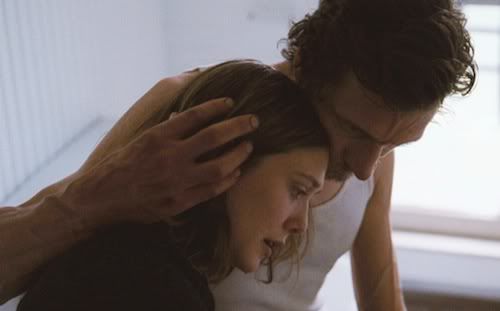
Pictured: Elizabeth Olsen and John Hawkes
Aside from its difficulty to say in a conversation, the title of Sean Durkin’s Martha Marcy May Marlene in fact gives you all the information you really need in summing up this mysterious and unsettling piece. For even in its final frames, the film bravely refuses to answer its most burning question: who is this girl?
MMMM gives us Martha (Elizabeth Olsen) a young woman who has spent two years living in upstate New York as a member of a small, subsistence-oriented cult, centered around a man named Patrick (John Hawkes). It is here that she gains her three extraneous names. We first meet Martha as she escapes from them, finding refuge with her somewhat-estranged sister Lucy (Sara Paulson) and Lucy’s husband Ted (Hugh Dancy), an affluent early-30s couple who live in a Connecticut lake house, where they invite Martha to stay with them. It quickly becomes apparent that their lack of understanding of what Martha has been through is not only damaging to Martha’s recovery, but to their own sanity as sister, wife, and husband.
Mr. Durkin allows his audience to know what is happening now and what has happened immediately prior. No more, no less. This leads to some frustrating holes in understanding the character of Martha, but is clearly a crucial element in the way Mr. Durkin has chosen to tell his story, as her anonymity is part of what makes the film so chilling. There is an eeriness to the blunt immediacy of this kind of storytelling, and given its subject matter (the seduction of cult lifestyle and the rejection thereof) such an undefined heroine allows us to project ourselves onto her vulnerability and ask that terrifying question of “Could this happen to me?”
With so little to take from the script as far as character history and relationships, Elizabeth Olsen’s performance can be considered nothing short of extraordinary. The camera focuses so often on her young, wide-eyed face that by the end one can interpret that one flinch of an eyelid speaks to the world of confusion and frustrated hurt beneath its surface.
The back-and-forth between the two worlds of past and present gives the story not only its structural complexity, but moral as well. Though no audience member could ever approve of the cult’s practices (one of which requires all newly inducted women – girls, rather - to be drugged and forced into sex with their leader, Patrick), its “acceptance of all” values and the soft warmth and charm of John Hawkes as Patrick make us realize that maybe Martha’s choice to leave the group was not so simple as we would feel comfortable believing. After all, she meant something there, her life had purpose, even if it was only to be the favorite of the man who controlled her.
That said, we are never led to believe she regrets her decision to escape. No, what we are left with at the end is a young woman who cannot reconcile the life she led, the life she was promised, and the life that awaits her in a world much bigger than the one she has come to know living on a farm in Upstate New York. She has abandoned one vision of right and wrong for another, one that allows her to own her body and her choices vs. one where she is scolded for swimming nude. When Lucy finally begs of Martha, “What happened to you?” and Martha, overwhelmed, collapses her head in her hands and sobs, “I don’t know!” we have no doubt this is the truth.